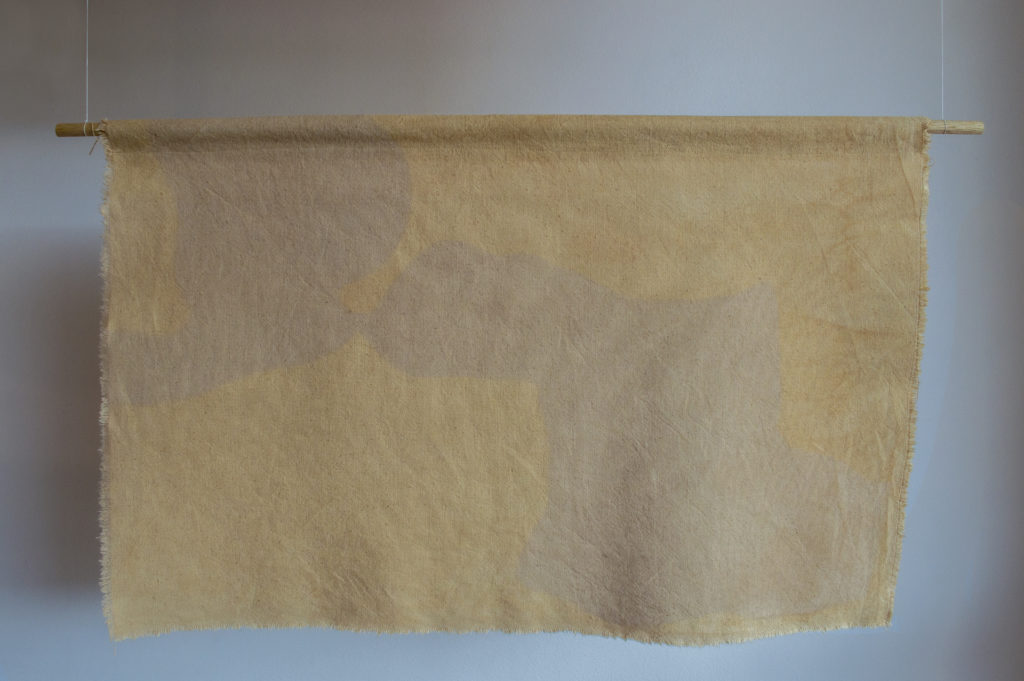English below
Blanqueamiento Territorial
Pintura instalativa
Teñido natural sobre madreselva con cortezas, frutos y raíces de árboles no nativos:
Nogal, Ciprés, Higuera, Rubia y Sauco negro y posterior blanqueamiento natural selectivo con luz solar
240 x 110 x 1cm
42 x 68cm cada pieza
2021 – hoy
La Amazonia está pasando por un proceso de transformación crítico. Hay un proyecto de planificación organizado, controlado y con gran capacidad económica, operativa y logística que diverge de la visión local del territorio. Allí se presenta un blanqueamiento multidimensional. Se blanquea lo que allí se produce y lo que allí sucede; se blanquean a los financiadores, a los acaparadores y a los deforestadores.
Blanqueamiento territorial es un serie de 6 telas tinturadas a mano con cortezas, frutos y raíces de árboles no nativos que luego pasan por un proceso de blanqueado selectivo natural dando resultado a 6 áreas deforestadas en la Amazonia colombiana. Son 6 registros tomados por la FCDS y Amazon Conservation durante el último año que muestran los procesos de colonización y blanqueamiento que se están llevando en esta región con unos intereses muy precisos por transformar radicalmente el territorio.
Las telas, que en un momento tuvieron un color homogéneo, se convierten en los mismos registros satelitales y aéreos de la Amazonia. Ambos – las telas y la Amazonia – pasan por un proceso de blanqueamiento – Whitewashing –. Un blanqueamiento que busca homogeneizar y blanquear el territorio: ponerlo al servicio de las lógicas extractivistas y neoliberales y quitarle todos sus atributos únicos y alternos al paradigma occidental. Es un blanqueamiento que funciona como metáfora a los múltiples procesos de alteración, ocultamiento, invisibilización, lavado y exoneración de las narrativas, acciones y actores vinculados a la problemática de la transformación amazónica.
Los áreas deforestadas de las 6 piezas son (de izquierda a derecha desde arriba)
- Cultivos de coca en El Parque Nacional Natural Sierra de la Macarena (Meta)
- Deforestación en el Resguardo Indígena Nukak Maku (Guaviare y Guanía)
- Carretera Calamar – Miraflores (Guaviare)
- Carretera ilegal y terrenos deforestados a sus lados en el Guaviare en el Resguardo Indígena Nukak Maku .
- Áreas deforestadas en el Parque Nacional Natural Serranía de Chiribiquete (Guaviare y Caquetá)
- Grandes fincas ganaderas y loteadas en el Guaviare.
Territorial Whitewashing
Installation painting
Natural dyeing on raw cotton with barks, fruits and roots of non-native trees:
Walnut, Cypress, Fig, Rubia and Black Elder and subsequent selective natural bleaching with sunlight.
240 x 110 x 1cm
42 x 68cm each piece
2021 – today
The Amazon is going through a critical transformation process. There is a very organized, controlled planning project with great economic, operational and logistical capacity that diverges from the local vision of the territory. There is a multidimensional whitewashing. What is produced and what happens there is whitewashed; funders, land grabbers and deforesters are whitewashed.
Territorial Whitewashing is a series of 6 hand-dyed fabrics with barks, fruits and roots of non-native trees that then go through a natural selective bleaching process which results in 6 deforested areas in the Colombian Amazon. These are 6 records taken by the FCDS and Amazon Conservation during the last year that show the colonization and whitewashing processes that are taking place in this region with very precise interests in radically transform the territory.
The fabrics, which at one time had a homogeneous color, become the same satellite and aerial records of the Amazon. Both – the fabrics and the Amazon – go through a whitewashing process -. A whitewashing that seeks to homogenize and whiten the territory: place it at the service of extractivist and neoliberal logics and remove all its unique and alternative attributes from the Western paradigm. It is a whitewashing that functions as a metaphor for the multiple processes of alteration, concealment, invisibility, laundering and exoneration of the narratives, actions and actors linked to the problem of Amazonian transformation.
The deforested areas of the 6 pieces are (from left to right from above)
- Coca crops in Sierra de la Macarena National Natural Park in Department of Meta.
- Deforestation in Nukak Maku Indigenous Reserve in Department of Guaviare & Guanía.
- Calamar – Miraflores Road in Department of Guaviare.
- Illegal highway and deforested land on either side in Nukak Maku Indigenous Reserve in Department of Guaviare.
- Deforested areas in Serranía de Chiribiquete National Natural Park in Department of Caquetá & Guaviare.
- Large cattle farms divided in lots in department of Guaviare.






